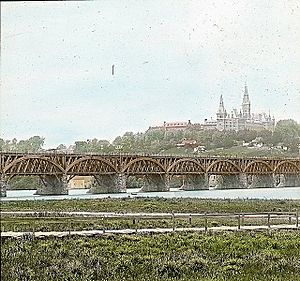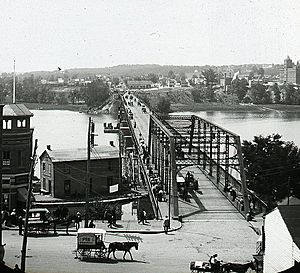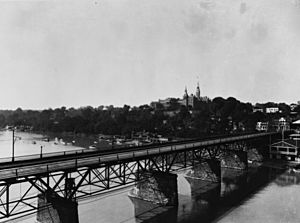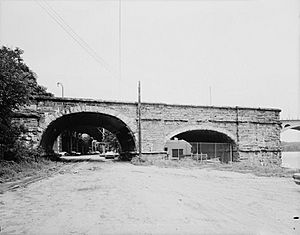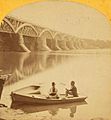Aqueduct Bridge (Potomac River) facts for kids
Quick facts for kids Aqueduct Bridge |
|
|---|---|
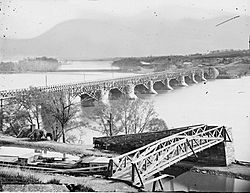
First Aqueduct Bridge between 1860 and 1865
|
|
| Carries | Cargo-carrying boats |
| Crosses | Potomac River |
| Locale | Georgetown, Washington, D.C. |
| Other name(s) | Alexandria Aqueduct |
| Named for | Aqueduct |
| Heritage status | Historic American Engineering Record |
| Followed by | Key Bridge |
| Characteristics | |
| Material | Wood |
| Width | 110 ft (34 m) |
| Height | 30 ft (9.1 m) |
| Number of spans | 8 |
| History | |
| Designer | Brevet Major William Turnbull, Superintending Topographical Engineer of the construction of the Potomac Aqueduct at Georgetown, D. C., 1832‑43 |
| Engineering design by | United States Army Corps of Topographical Engineers |
| Construction begin | 1833 |
| Construction end | 1843 |
| Construction cost | $240,000 |
| Opened | 1843 |
| Collapsed | 1933 |
| Closed | 1923 |
The Aqueduct Bridge (also known as the Alexandria Aqueduct) was an important bridge connecting Georgetown, Washington, D.C., and Rosslyn, Virginia. Its main job was to carry boats filled with goods from the Chesapeake and Ohio Canal in Georgetown across the Potomac River. These boats were heading to the Alexandria Canal.
Over time, the same eight stone supports (called piers) held up two different bridges. First, there was a wooden bridge that carried water and boats. Later, a wooden road was added on top of it. Much later, an iron truss bridge was built on the same piers. This second bridge carried a road and an electric trolley line. The Aqueduct Bridge was closed in 1923 after the nearby Key Bridge was built. The old bridge was taken down in 1933.
Contents
History of the Aqueduct Bridge
Building the First Bridge
In 1830, business people from Alexandria, Virginia, wanted to connect their city to Georgetown. They hoped to use the new Chesapeake and Ohio Canal for trade. So, in 1830, Congress allowed the Alexandria Canal Company to build a bridge. This bridge would carry canal boats across the Potomac River. This meant boats wouldn't have to unload their goods in Georgetown.
Major William Turnbull designed the bridge. Construction of the bridge and the Alexandria Canal started in 1833. Both were finished in 1843. To protect the bridge from large chunks of ice in the Potomac River, the piers were made of strong stone called gneiss. They also had pointed icebreakers made of granite.
The first bridge was like a wooden trough filled with water. It was built using a special design called a queen-post truss. The bridge was about 110 feet (33.5 m) wide at the top. It had eight piers, each about 7 feet (2.1 m) wide at the top. Two of the piers were wider, at 16 feet (4.9 m). The top of each pier was about 30 feet (9.1 m) above the average water level.
At first, a narrow road ran next to the canal bridge. Later, a separate level was added for people walking and carriages. Charging tolls on this new road made it harder for trade between Georgetown and Virginia. This helped businesses in Alexandria.
During the American Civil War, the canal was drained. This turned the bridge into a road for military troops.
In 1866, the Alexandria Canal Company rented the bridge to three local businessmen for 99 years. The old wooden top part of the bridge was falling apart. It was replaced with a new design called Howe trusses. Later, wooden arches were added to make the Howe trusses even stronger. In 1868, Congress passed a law saying the people renting the bridge had to keep a road on it. To pay for this, they were allowed to charge a toll. A wooden floor was put on top of the Howe trusses. Wooden trestles were built at both ends to connect the bridge to the land.
The Second Bridge is Built
By 1882, people in Congress wanted to buy the Aqueduct Bridge and make it free for everyone to use. This idea didn't pass at first. But in 1884, new laws were introduced and finally passed. A big question was who would pay for the bridge. Congress first suggested that Washington, D.C., pay for it all. But the city didn't have enough money. People in Virginia argued that Congress should pay because it was a bridge between two areas.
Congress agreed and set aside $240,000 to buy the bridge. The Alexandria Canal Company sold the bridge's piers for $85,000 and its top part for $50,000. The bridge officially became federal property on August 15, 1884.
Soon after, people worried about how safe the bridge was. In December 1885, the United States Army Corps of Engineers studied the bridge. They found the wooden bridge was so unsafe it should be removed. Again, the cost was a big concern. In May 1886, a law was proposed in Congress to build a new bridge. The D.C. government would pay half the cost. Another study in September 1886 said the bridge was so unsafe it should close right away. The city closed it on October 5, 1886.
After some legal issues were sorted out, the federal government decided to build a new bridge. In January 1887, the Corps of Engineers said a new bridge could be built for $105,000. This money was already available from the earlier purchase. So, no new laws were needed.
Work on the new bridge began in August 1887. There were many delays. One reason was needing permission from the Chesapeake and Ohio Canal, which the bridge would cross. Despite problems, the new bridge finally opened on June 1, 1889.
In 1889, a northern arch in the Washington side of the bridge was made bigger. This allowed the Georgetown Branch of the Baltimore and Ohio Railroad to pass underneath. Later, when that train line was no longer used, Water Street NW was extended through this arch. One of the bridge's piers was replaced in 1900.
In 1906, the Great Falls and Old Dominion Railroad (GF&OD) started running an electric trolley line on the bridge. They built a special structure on the west side of the bridge for this. In 1912, the GF&OD became part of the Washington and Old Dominion Railway.
Replacing the Aqueduct Bridge
People started suggesting replacing the Aqueduct Bridge as early as 1901. These plans were put on hold for a while. In 1902, Congress approved building a wooden structure on the side of the bridge to carry electric trolleys between Georgetown and Rosslyn. Construction started in May 1903. This work included rebuilding one of the bridge's piers. Trolleys used this part of the bridge until it closed in 1923.
Large ice jams were common on the Potomac River. The Aqueduct Bridge usually handled them well until 1908. That year, ice damaged some of the bridge's piers. Pier No. 1 had to be rebuilt. Engineers also found that water had worn away the bases of many piers, so quick repairs were made. But the old bridge kept getting damaged. By September 1912, it was leaning dangerously. People worried it would collapse during the spring ice jams. The bridge piers were repaired again in 1913.
The Carlin Bill and Key Bridge
In March 1914, Representative Charles Creighton Carlin from Virginia suggested building a new bridge for $1 million. The leaders of Washington, D.C., agreed in June. But there was an argument about where the new bridge should go. Senator Claude A. Swanson wanted it built further downstream, near Rock Creek. This would mean crossing Analostan Island to Rosslyn. But Georgetown businesses strongly disagreed.
Some in Congress wanted to just repair the old bridge. However, a study by the United States Army Corps of Engineers in August 1914 showed the old bridge was too weak for all the traffic and too unstable to be saved. Secretary of War Lindley Miller Garrison agreed that a new bridge was needed. Representative William C. Adamson argued that the new bridge should be built in the same spot as the old one.
The Carlin bill, which proposed the new bridge, started moving through Congress in January 1915. But members of the House of Representatives thought it was too expensive. Secretary Garrison tried to help by saying the old bridge was unsafe and the new one should be built in the same place. The D.C. leaders said they would decide the location. The Corps of Engineers warned that the old bridge couldn't be made bigger and was indeed unsafe. Senator Swanson changed his mind and agreed in January 1916 that the new bridge should be built on the old site.
Because the Aqueduct Bridge was so dangerous, the city limited traffic to only one car at a time starting February 3, 1916. The House of Representatives passed a law on March 6 to spend $1.175 million on a new bridge. After more discussions and agreements, the Carlin bill passed Congress on May 2, 1916. President Woodrow Wilson signed it into law on May 19.
Taking Down the Aqueduct Bridge
On June 1, 1916, the Army Corps of Engineers named the new bridge "Francis Scott Key Bridge." This was to honor the man who wrote the words to The Star Spangled Banner. His home was close to the bridge. Plans for the new bridge were almost finished by September. When repairs were made to the Aqueduct Bridge in October 1916, even more damage was found.
In January 1917, the Corps of Engineers found that building materials had become more expensive. They needed an extra $300,000 from Congress. Congress didn't want to pay at first. But people pushed for it, and the danger of the bridge collapsing from ice in the spring convinced Congress to provide the money. Construction started in March. The new $2.35 million Key Bridge opened on January 17, 1923. At that time, the Aqueduct Bridge was closed to all traffic.
Even though some people in Georgetown wanted the old Aqueduct Bridge to stay open for fun activities, it began to be taken down in December 1933. The top part of the Aqueduct Bridge and most of its piers above the water were removed in 1933. The bases of the piers were left in place. They helped protect the Key Bridge's piers from damage by ice.
However, these remaining piers bothered people who used boats on the river, especially rowers from Georgetown University. They said the piers were in the way and dangerous. Army engineers and Representative Joel Broyhill first refused to remove them. They said the piers protected Key Bridge and it would cost too much to remove them. But in August 1962, they agreed to remove seven of the eight piers. One pier would stay as a historical marker. The removal of the piers started on September 11, 1962. The bases were blasted away to about 12 feet (3.7 m) below the water.
The Washington side of the Aqueduct Bridge's support structure (called an abutment) and a small part of the Virginia abutment still exist today. They are a short distance upstream from the Key Bridge. The southern arch of the Washington abutment is now used to store rowing shells for the Potomac Boat Club. Between the abutments, the one preserved pier remains near the Virginia shoreline.
Some groups in Georgetown and Georgetown University have suggested building a gondola (like a cable car) across the river. It would follow the old path of the Aqueduct Bridge. Pictures show that a pole supporting the gondola's cables would rise from the remaining pier.
Images for kids
-
Aerial view of Key Bridge and George Washington Memorial Parkway, with pier of Aqueduct Bridge visible in the foreground and remnant of Aqueduct Bridge abutment visible on the Virginia shoreline (c. 1990)
-
Pier and remnant of Virginia abutment of the Aqueduct Bridge upstream of Key Bridge (2005)
See Also


